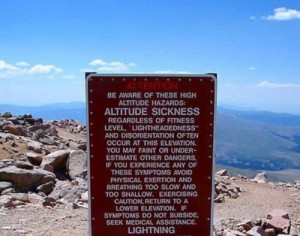Altitude sickness occurs when the lungs cannot get enough oxygen from the air, specifically at high altitudes. It is also commonly called mountain sickness. It mostly occurs to people who are not used to high altitudes too quickly, specifically at altitudes 2438m (8000ft) or higher. There are three forms of altitude sickness, which will be discussed later. There is no way to determine who are more prone to altitude sickness or what gender, as it can occur to anyone who might be physically fit. Altitude sickness can be dangerous and need to be treated.
Types of Altitude Sickness
There are several types of altitude sickness.
- Acute Mountain Sickness (AMS)
- Most mild and most common
- High Altitude Pulmonary Edema (HAPE)
- Dangerous fluid buildup in the lungs which prevents air spaces from opening up and filling with fresh air
- Symptoms typically manifest two to three days
- May be fatal
- High Altitude Cerebral Edema (HACE)
- Severe form of AMS
- Begins with brain confusion
- May be fatal within a few hours
Causes of Altitude Sickness
Symptoms of Altitude Sickness
Air in higher altitudes has lower air pressure, thus it is thinner. Because of the decreased pressure, the body cannot get as much oxygen as it needs, thus leading to symptoms. The symptoms will vary on the type and may be mild to severe. Symptoms may not necessarily manifest at the arrival at high altitude. Sometimes, symptoms may symptoms after 24 hours.
- Throbbing headache, which worsens during the night and when you wake up
- Shortness of breath
- Dizziness
- Nausea and possibly, vomiting
- Loss of appetite
- Difficulty sleeping
- Exhaustion
- Weakness and fatigue
- Feeling lazy
First Aid Management for Altitude Sickness
Early diagnosis is important in altitude sickness. It is easiest to 
- Climb down or descend to a much lower altitude as quickly and safely as possible.
- If oxygen is available, this can also be an option.
- Medications are also available to hasten the body’s acclimatizing to the higher altitude.
- However, if symptoms are mild, this may not be necessary as the body may get used to the lower air pressure. But if one chooses to remain at higher altitudes, rest first. Limit activity and drink plenty of water.
- For headaches, over-the-counter painkillers, such as acetaminophen or ibuprofen may be taken.
- Avoid going to higher altitudes until symptoms disappear completely.
Prevention of Altitude Sickness
There are several ways to prevent altitude sickness:
- If one plans to go altitudes beyond 2438m (8000ft) or higher, spend a night in the medium altitude before going higher for the lungs to be able to adjust.
- Avoid large meals, alcohol and extreme activities before going into high-altitude.
- Take plenty of rest and drink lots of liquid. Include a lot of carbohydrate in the diet.
The best treatment for altitude sickness is prevention. Before planning to go into high-altitude places, register to join in First Aid Training to learn how to treat altitude sickness and other high-altitude injuries or conditions.

